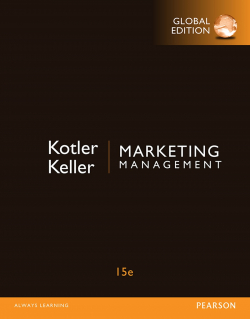Marketing Management

Buy online ($)
Type
Book
ISBN 10
1292404817
ISBN 13
9781292404813
Category
Reference
[ Browse Items ]
Publication Year
2022
Publisher
Pearson Education Limited, Singapore
Pages
605 p.: ill.
Subject
1. Marketing--Management.
Tags
Abstract
The 16th edition of Marketing Management builds on the classic examples, core concepts, and logical
structure that made the first edition a landmark text. Much has changed since the 15th edition was
published. Ongoing globalization; the increasing role of corporate social responsibility; advances in
technology, e-commerce, and digital communication; the growing impact of social media, and the
widespread use of data analytics, marketing automation, and artificial intelligence have disrupted
many industries and have opened doors to new business models. Responding to these changes, the
16th edition was redesigned from the ground up to provide managers with the tools necessary to
succeed in the new market environment.
Marketing Management owes its success to its maximization of three dimensions of marketing
coverage: depth, breadth, and relevance. The depth includes its solid academic grounding; its examina-
tion of important theoretical concepts, models, and frameworks; and its ability to provide conceptual
guidance to solve practical problems. The breadth reflects the wide range of topics addressed in the
book and its emphasis on those topics that are most crucial to marketing management. The relevance is
embodied by the ability of this book to identify the issues commonly faced by managers and present
the material in a way that enables them to develop successful strategies to address these issues.
The 16th edition builds on the fundamental strengths of past editions that distinguish Marketing
Management from all other marketing management texts:
Managerial orientation. The book focuses on the major decisions that marketing managers and
top management face in their efforts to harmonize the organization's objectives, capabilities, and
resources with marketplace needs and opportunities.
Analytical approach. The text presents conceptual tools and frameworks for analyzing
recurring problems in marketing management. Cases and examples illustrate effective marketing
principles, strategies, and practices.
Multidisciplinary perspective. Marketing Management draws on the rich findings of various
scientific disciplines-such as economics, behavioral science, and management theory-for
fundamental concepts and tools that are directly applicable to marketing challenges.
• Universal applications. The book applies strategic thinking to the complete spectrum of
marketing: products, services, persons, places, information, ideas, and causes; consumer and
business markets; profit and nonprofit organizations; domestic and foreign companies; small
and large firms; manufacturing and intermediary businesses; and low- and high-tech industries.
Comprehensive and balanced coverage. Marketing Management covers the topics a manager
must understand in order to design and execute a successful marketing campaign.
What's New in the 16th Edition
The overriding goal of the revision for the 16th edition of Marketing Management was to create a com-
prehensive, current, and engaging marketing text. We streamlined the organization of the content,
added new material, cut or updated older material, and deleted material that was no longer relevant or
necessary. The 16th edition allows those instructors who have used previous editions to build on past
experience, while at the same time offering a text that is unsurpassed in breadth, depth, and relevance
for students experiencing Marketing Management for the first time.
To improve the presentation of the material, individual chapters are organized into seven rather
than eight major parts, as described next. We retained many of the favorably received within-chapter
features that have been introduced through the years, such as topical chapter openers, examples high-
lighting noteworthy companies or issues, and the Marketing Insight and Marketing Spotlight features that
provide in-depth conceptual and company-specific information. Most of the chapter-opening vignettes,
in-text examples, and end-of-chapter features are new, reflecting current market developments.
structure that made the first edition a landmark text. Much has changed since the 15th edition was
published. Ongoing globalization; the increasing role of corporate social responsibility; advances in
technology, e-commerce, and digital communication; the growing impact of social media, and the
widespread use of data analytics, marketing automation, and artificial intelligence have disrupted
many industries and have opened doors to new business models. Responding to these changes, the
16th edition was redesigned from the ground up to provide managers with the tools necessary to
succeed in the new market environment.
Marketing Management owes its success to its maximization of three dimensions of marketing
coverage: depth, breadth, and relevance. The depth includes its solid academic grounding; its examina-
tion of important theoretical concepts, models, and frameworks; and its ability to provide conceptual
guidance to solve practical problems. The breadth reflects the wide range of topics addressed in the
book and its emphasis on those topics that are most crucial to marketing management. The relevance is
embodied by the ability of this book to identify the issues commonly faced by managers and present
the material in a way that enables them to develop successful strategies to address these issues.
The 16th edition builds on the fundamental strengths of past editions that distinguish Marketing
Management from all other marketing management texts:
Managerial orientation. The book focuses on the major decisions that marketing managers and
top management face in their efforts to harmonize the organization's objectives, capabilities, and
resources with marketplace needs and opportunities.
Analytical approach. The text presents conceptual tools and frameworks for analyzing
recurring problems in marketing management. Cases and examples illustrate effective marketing
principles, strategies, and practices.
Multidisciplinary perspective. Marketing Management draws on the rich findings of various
scientific disciplines-such as economics, behavioral science, and management theory-for
fundamental concepts and tools that are directly applicable to marketing challenges.
• Universal applications. The book applies strategic thinking to the complete spectrum of
marketing: products, services, persons, places, information, ideas, and causes; consumer and
business markets; profit and nonprofit organizations; domestic and foreign companies; small
and large firms; manufacturing and intermediary businesses; and low- and high-tech industries.
Comprehensive and balanced coverage. Marketing Management covers the topics a manager
must understand in order to design and execute a successful marketing campaign.
What's New in the 16th Edition
The overriding goal of the revision for the 16th edition of Marketing Management was to create a com-
prehensive, current, and engaging marketing text. We streamlined the organization of the content,
added new material, cut or updated older material, and deleted material that was no longer relevant or
necessary. The 16th edition allows those instructors who have used previous editions to build on past
experience, while at the same time offering a text that is unsurpassed in breadth, depth, and relevance
for students experiencing Marketing Management for the first time.
To improve the presentation of the material, individual chapters are organized into seven rather
than eight major parts, as described next. We retained many of the favorably received within-chapter
features that have been introduced through the years, such as topical chapter openers, examples high-
lighting noteworthy companies or issues, and the Marketing Insight and Marketing Spotlight features that
provide in-depth conceptual and company-specific information. Most of the chapter-opening vignettes,
in-text examples, and end-of-chapter features are new, reflecting current market developments.
Description
Contents:
PART 1 Fundamentals of Marketing Management
Chapter 1 Defining Marketing for the New Realities
Chapter 2 Marketing Planning and Management
PART 2 Understanding the Market
Chapter 3 Analyzing Consumer Markets
Chapter 4 Analyzing Business Markets
Chapter 5 Conducting Marketing Research
PART 3 Developing a Viable Market Strategy
Chapter 6 Identifying Market Segments and Target Customers
Chapter 7 Crafting a Customer Value Proposition and Positioning
PART 4 Designing Value
chapter 8 Designing and Managing Products
chapter 9 Designing and Managing Services
Chapter 10 Building Strong Brands
Chapter 11 Managing Pricing and Sales Promotions
PART 5 Communicating Value
Chapter 12 Managing Marketing Communications
Chapter 13 Designing an integrated Marketing Campaign in the Digital Age
Chapter 14 Personal Selling and Direct Marketing
PART 6 Delivering Value
Chapter 15 Designing and Managing Distribution Channels
Chapter 16 Managing Retailing
PART 7 Managing Growth
Chapter 17 Driving Growth in Competitive Markets
Chapter 18 Developing New Market Offerings
Chapter 19 Building Customer Loyalty
Chapter 20 Tapping into Global Markets
Chapter 21 Socially Responsible Marketing
PART 1 Fundamentals of Marketing Management
Chapter 1 Defining Marketing for the New Realities
Chapter 2 Marketing Planning and Management
PART 2 Understanding the Market
Chapter 3 Analyzing Consumer Markets
Chapter 4 Analyzing Business Markets
Chapter 5 Conducting Marketing Research
PART 3 Developing a Viable Market Strategy
Chapter 6 Identifying Market Segments and Target Customers
Chapter 7 Crafting a Customer Value Proposition and Positioning
PART 4 Designing Value
chapter 8 Designing and Managing Products
chapter 9 Designing and Managing Services
Chapter 10 Building Strong Brands
Chapter 11 Managing Pricing and Sales Promotions
PART 5 Communicating Value
Chapter 12 Managing Marketing Communications
Chapter 13 Designing an integrated Marketing Campaign in the Digital Age
Chapter 14 Personal Selling and Direct Marketing
PART 6 Delivering Value
Chapter 15 Designing and Managing Distribution Channels
Chapter 16 Managing Retailing
PART 7 Managing Growth
Chapter 17 Driving Growth in Competitive Markets
Chapter 18 Developing New Market Offerings
Chapter 19 Building Customer Loyalty
Chapter 20 Tapping into Global Markets
Chapter 21 Socially Responsible Marketing
Biblio Notes
Notes:
Includes bibliographical references and index.
Includes bibliographical references and index.
Number of Copies
1
| Library | Accession No | Call No | Copy No | Edition | Location | Availability |
|---|---|---|---|---|---|---|
| Main | 898 | HF5415.13 K68 2022 | 1 | Sixteenth Edition | Reserve Section | Yes |




